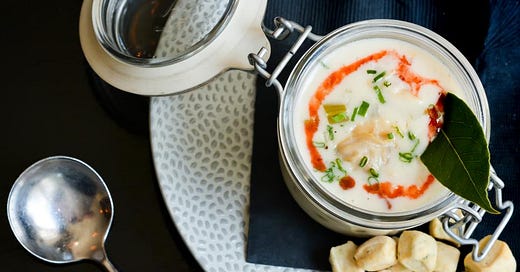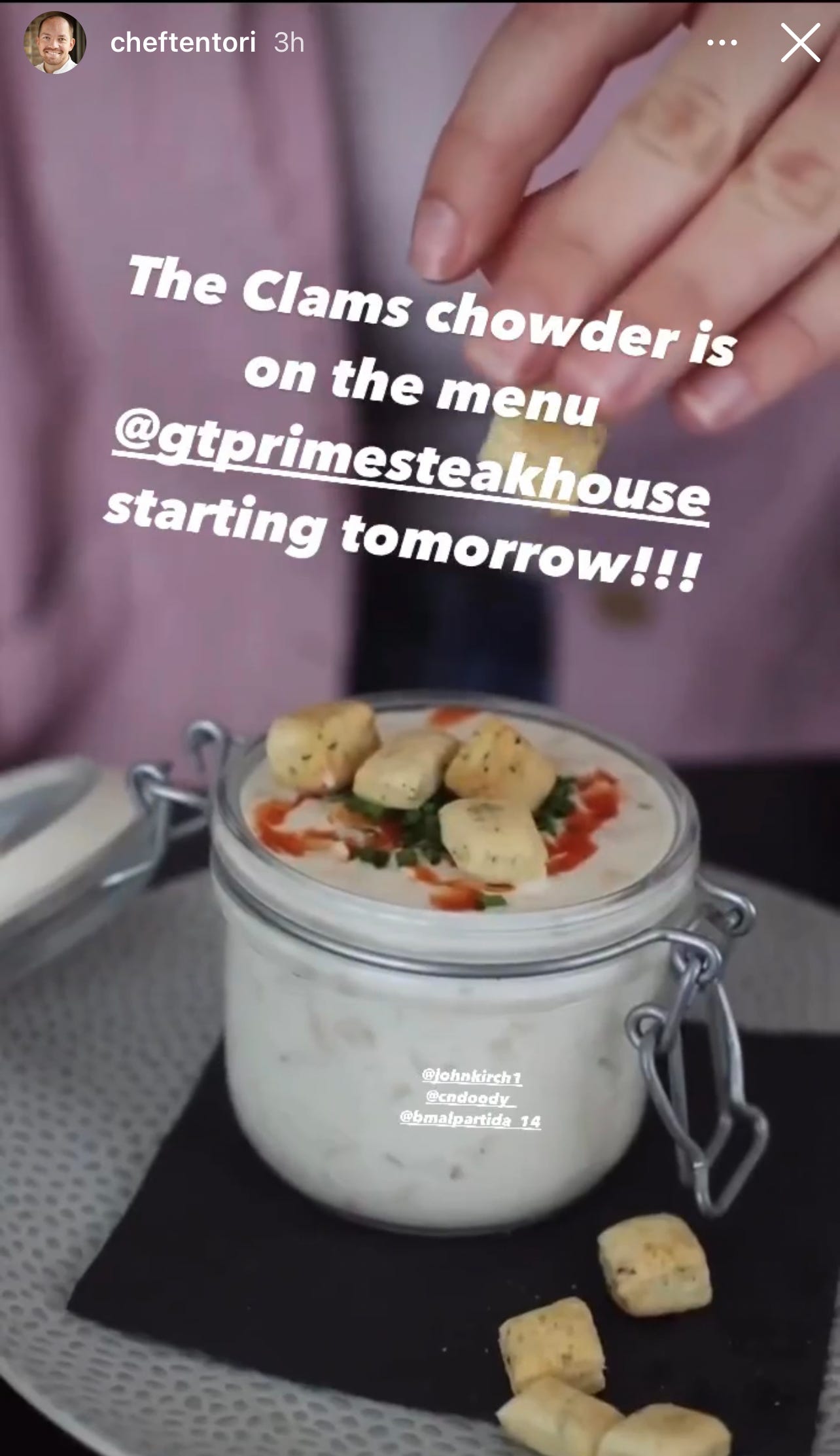GT Fish & Oyster is Dead, Long Live GT Fish!
A quick oral history of GT Fish & Oyster's clam chowder, aka, the hug in a mug, back for a limited time at GT Prime
Working fourteen hours on the line, day after day, in the best restaurant in America, where the head chef Charlie Trotter was sometimes as mercurial as Terence Fletcher, the drum teacher from the movie Whiplash, was as demanding as any restaurant cooking job in America.
Chef Giuseppe Tentori, of GT Prime, would never say that. In fact when I asked him about those long hours, he didn’t complain. Rather he immediately said, “It was exactly what I signed up for.”
Tentori’s dedication is why he was one of the few to ever work his way up to chef de cuisine at Trotter’s, to be the guy behind the guy. But, no matter how passionate you are, no matter how much you love something, working that long, on your feet, in the swelter of an oven range requires a respite, a moment of comfort wherever you can find it.
For many chefs, and especially Tentori, that solace was found at daily family meal (staff take turns preparing a meal for all of their co-workers to eat before service) in a bowl of clam chowder. Given that this was Charle Trotter’s, you might imagine some deconstruction, a clear gelee of broth garnished with tiny potato souffles, fried clams, and swizzled bacon jus.
Because it’s an object of comfort, family meal, rarely apes the restaurant’s cuisine. It is more likely grounded in mom technique, aka the dump and stir, albeit sometimes by a culinary school trained chef with access to better ingredients.
The Trotter’s family meal chowder wasn’t a deconstruction. It was a rustic creamy broth, with one twist: because the restaurant had a rich larder, the stock or soup could be spiked with crab, oysters, or bass.
“It was clam chowder on steroids. We only did it in the winter when it was cold. I just remember that five minutes of relaxation, sipping it from a deli cup. That clam chowder was the only break during a long shift,” said Tentori
Tentori, who was raised in Italy, never had clam chowder before Trotter’s. He said, “No. Never. I grew up in a poor family. When I had my first lobster roll in Naples, Florida, I didn’t understand it. I thought it was going to be like a maki roll or something.”
Which is to say, absent of a childhood nostalgia touchstone, you know the pause for family meal clam chowder at Trotter’s was more than a quick slurp. It was a daily salvation for Tentori, and that's why it became the foundation for the menu at GT Fish & Oyster.
As a student of Chicago history, it’s hard to come up with maybe more than twenty supremely identifiable local signature restaurant dishes. I would argue the GT clam chowder is somewhere in the pantheon, up there with bacon-wrapped dates at Avec, black truffle explosion at Alinea, or crispy pig face at Girl and the Goat.
I remember the first time I visited GT Fish, my server pimped it so excitedly, by the end of her pitch, I was positive the chowder contained the fountain of youth and would make me rich. But, because I was reckless and young and didn’t want to be told what to do, I didn’t order it.
I’m sure it was fantastic, but also in some ways I was fortunate, because while the early version was, I am told, delicious, it was a little more pedestrian than the version that eventually captured my imagination.
When Tentori was considering dishes for GT Fish & Oyster, he knew he needed a chowder (the word chowder is thought to be a bastardization of the French word chaudron or cauldron, or from the French-Canadian chaudiere or bucket). He considered tomato-based Manhattan chowder, and befitting a guy who made his bones at Trotter’s, even a “clear” consommé.
But, Tentori returned to the classic cream base that he remembered from his days as a young cook. The problem with chowder, if there is one, is that when you deploy the classic method, the celery and onions get cooked down so much they lose their aromatic quality, the salt pork gets soggy, and the potatoes disintegrate.
The classic flour and butter-roux based method of making the broth is often thick and gluey and obscures the clam and all the other rich flavors. As classics go, I really love the one served at Union Oyster House in Boston (allegedly the first restaurant in America to serve clam chowder) but even their version suffers some one-note, one-texture indignity.
Tentori settled on a corn-starch thickener for his mostly clam and heavy cream-spiced-base spiked with rendered garlic, onion, and celery so that the flavors of the sea stood front and center.
The original version used bacon, fresh littleneck clams, a small square dice of crispy potato, chopped chives, and celery. Tentori’s cream and clam base is heated to order, and all of the other elements are added fresh at the last minute so they retain their texture and flavor.
The only thing left to figure out was the serving vessel, which after some brainstorming with David LeFevre, a former Trotter alum who ran his own seafood restaurants, resulted in the selection of a fliptop Mason jar. It was the kind of vessel you’d pickle okra or serve granny’s raspberry jam in, but not clam chowder.
Of the chowder, my friend Penny Pollack, once the food editor of Chicago magazine, wrote, “Does food taste better in Mason jars? I think the clam chowder @GT Fish & Oyster would taste terrific even if it were served in an old shoe.”
She was absolutely right. Like one of my favorite Formula 1 race car drivers, Daniel Ricciardo, I would come to love the chowder so much, I'd totally do a “shoey” of it. But, a shoey, while a spectacle, would not quite have the practical ceremony of delivering the sealed jar to the table and flipping the top for the guest so that they got that briny creamy perfume wafted into their nostrils just before digging in.
If you wanted to go straight Emeril and kick it up a notch, the OG version was also served with your choice of “smolder” or “burn” Fresno and tabasco chili-based house hot sauces so you could heat up the chowder to taste. The original chowder versions were served with a packet of commercially-baked crackers.
Tentori didn’t like the “dry” nature of those crackers. He knew that the soup was still lacking a worthy “crouton” so he collaborated on a house-made cracker that was a little more hydrated and featured flecks of thyme, black pepper, and chili flake.
One of GT Fish’s early patrons was Bob Nueske, second generation owner of the best bacon maker in the world (R.W. Apple, the NYT writer once called Nueske’s bacon the Rolls Royce of rashers).
Tentori said, “He’d (Nueske) come in a lot with his sons and his wife. He was the nicest guy ever. He was like a gentle giant.” The relationship convinced Tentori to sub in Nueske’s for the standard bacon they were using in the chowder.
Evolution has its limits. Tentori is always tinkering, but he said, I remember the day I learned that “consistency is sometimes more important than creativity”. He added, “We started to experiment, and we added smoked duck and corn to the chowder. A table of six people came in only for the chowder. As soon as they saw that it wasn’t the chowder they expected, they were so upset, they all left the restaurant.”
I asked chef Tentori if HE considered it a signature dish. He said, “I do. I’m no trying to be cocky, but I think it’s one of the better clam chowders out there. It’s not just soup. It’s kind of a less is more approach that warms you up with bacon, clam, and cream. When you taste it, it’s like how you wake up in the morning from a deep sleep. You don’t want to get out of bed. The chowder is kind of like the blanket, a hug that you need.”
___
I’m writing about GT Fish’s clam chowder, because it’s back baby! Starting this weekend you can get it at GT Prime located at 707 N. Wells in Chicago






Bob Nueske is a gem! I met with him in numerous times for bacon fest.